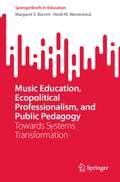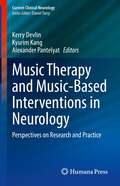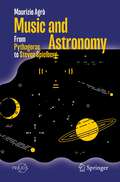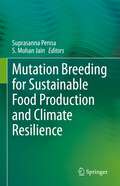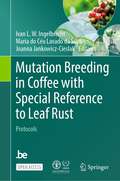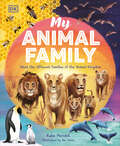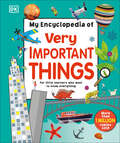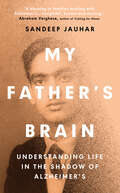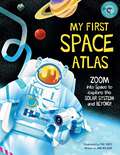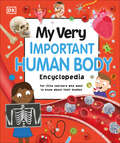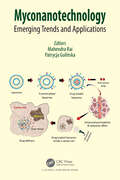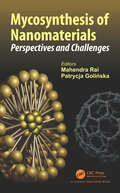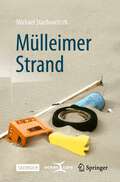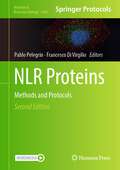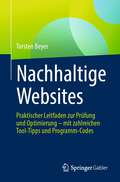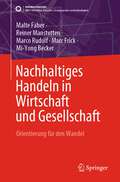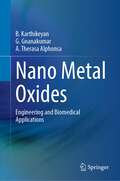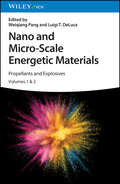- Table View
- List View
Music Education, Ecopolitical Professionalism, and Public Pedagogy: Towards Systems Transformation (SpringerBriefs in Education)
by Margaret S. Barrett Heidi M. WesterlundThis book challenges the dominant expertise professionalism rationale for music education by responding to the call to develop ‘ecological awareness’ at a time when all professions have a moral obligation to place sustainable and interdependent life at the center. The book aims to expand music education’s professional horizons to acknowledge the responsibility of the music field to contribute to the demands of complex questions of sustainability and identify the ways in which sustainable music education may be strengthened through an activist relational ecological stance. It suggests a radical moral turn by asking: What if music education is recognised as part of the problem of sustaining unsustainability? and What if music teacher education was developed in and through dialogue with a futures perspective? These questions are interrogated through a critical analysis of the historical positioning of music in education and an interdisciplinary application of theories of ecology and professionalism.
Music Therapy and Music-Based Interventions in Neurology: Perspectives on Research and Practice (Current Clinical Neurology)
by Kerry Devlin Kyurim Kang Alexander PantelyatThis book synthesizes knowledge about the myriad ways music can support the physical and psychosocial needs of people living with neurological diagnoses. It may be a useful tool for those working or training as music therapists, as well as clinicians and patients interested in the use of music and rhythm to address individualized healthcare goals. The editors of this book advocate for a collaborative, holistic approach to the implementation of music-based interventions, acknowledging that different (and at times, conflicting) approaches do exist – and that different patients may require exploration of different approaches to have their needs and desires met in ways most meaningful to them. The book’s many contributors embody this desire to hold space for wide-ranging views on clinical practice through the ways they share their own perspectives as music therapists, neurologists, nurses, speech and language pathologists, and neuroscience researchers from across the globe.Each chapter is centered around clinical work in context with a specific patient community – be that a diagnosis (e.g., movement disorders), shared culture (e.g., autistic culture), disease stage (e.g., end of life), or targeted clinical need (e.g., psychosocial support and/or functional performance) – and features a summary of available research with case examples and clinical descriptions to highlight different conceptualizations of the role of music in the care of patients with neurologic diagnoses.
Music and Astronomy: From Pythagoras to Steven Spielberg (Springer Praxis Books)
by Maurizio AgròThis book explores the profound and ancient relationship between music and astronomy. Throughout history, Music has occupied a significant place among the disciplines of the Quadrivium, which also include Geometry, Arithmetic, and Astronomy. The captivating bond between these two realms has not only inspired eminent scientists like Kepler, Newton, and Einstein, but has also captured the imagination of NASA and astronauts in modern times. The author delves into various aspects of the intersection between music and astronomy, encompassing everything from ancient cosmological beliefs to groundbreaking discoveries such as the cosmic background radiation and gravitational waves. This enthralling theme has not only stimulated renowned artists like David Bowie and Elton John, but has also served as a muse for movies like Close Encounters of the Third Kind. Within the book, readers will find an extensive photo gallery and a specially curated soundtrack that enhances the reading experience. It caters to a broad audience, appealing to those with a general interest in both music and astronomy, as well as to specialized individuals in either field of study.
Mutation Breeding for Sustainable Food Production and Climate Resilience
by S. Mohan Jain Suprasanna PennaThis book highlights the recent progress on the applications of mutation breeding technology in crop plants. Plant breeders and agriculturists are faced with the new challenges of climate change, human population growth, and dwindling arable land and water resources which threaten to sustain food production worldwide. Genetic variation is the basis which plant breeders require to produce new and improved cultivars. The understanding of mutation induction and exploring its applications has paved the way for enhancing genetic variability for various plant and agronomic characters, and led to advances in gene discovery for various traits. Induced mutagenesis has played a significant role in crop improvement and currently, the technology has resulted in the development and release of more than 3600 mutant varieties in most of the crop plants with great economic impact. The field of ‘mutation breeding’ has come long way to become an important approach for crop improvement. This book covers various methodologies of mutation induction, screening of mutants, genome editing and genomics advances and mutant gene discovery. The book further discusses success stories in different countries and applications of mutation breeding in food crops, horticultural plants and plantation crops.This informative book is very useful to plant breeders, students and researchers in the field of agriculture, plant sciences, food science and genetics.
Mutation Breeding in Coffee with Special Reference to Leaf Rust: Protocols
by Joanna Jankowicz-Cieslak Ivan L. W. Ingelbrecht Maria do Céu Lavado da SilvaThis open-access book provides a comprehensive overview of current methodologies for improving resistance to leaf rust in coffee, one of the world's most important cash crops and beverages. Coffea arabica L. (Arabica) accounts for about 60% of the world's coffee production. Coffee leaf rust (CLR), caused by the fungus Hemileia vastatrix is the major disease affecting Arabica coffee resulting in losses of over $1 billion annually. The geographical distribution of CLR is expanding due to climate change. Moreover, the genetic improvement of Arabica coffee is constrained due to its very narrow genetic base. This protocol book introduces essential concepts of mutation breeding as an efficient tool to increase the genetic diversity of Arabica coffee and presents practical methods on mutation induction and screening for resistance to CLR. Current breeding approaches, challenges and opportunities for Arabica coffee improvement are briefly reviewed and a survey of common coffee diseases with emphasis on CLR is presented. Practical protocols for mutation induction and screening for resistance to CLR are described, including novel methods for single-cell mutagenesis using in vitro cell and tissue culture techniques and for genome-wide screening of induced mutations using genomics tools. Each protocol chapter has an introduction and is supported by example results. Given the impact of recent CLR epidemics on Arabica coffee production in Latin America, the book is intended to serve as a timely reference and guide for students and researchers in the agricultural sciences, plant pathologists and breeders, as well as growers and end-users interested in producing novel coffee genotypes for genetic studies, breeding, and commercial applications.
My Animal Family: Meet The Different Families of the Animal Kingdom
by Kate PeridotMeet some very different animal families, and discover who does what, in this book for children about the various social structures across the animal kingdom.In the animal kingdom, just like the human one, families come in all shapes and sizes. Throughout the pages of this beautifully illustrated book, you&’ll begin to see animals in a whole new light.Children aged 5-7 will love to learn about the different animal families and compare these experiences to their very own! Discover who&’s the boss, who looks after the children, and who&’s in charge of getting dinner. Meet a different animal family on every page, learn about what it&’s like to live in the group, how they communicate with each other, and the names of the group, males, females, and young.Inside the pages of this beautiful animal book, you&’ll find:- Information on around 20 animal families, including elephants, penguins, chimpanzees, dolphins, crows, bees, and wolves.- Pages are written from the perspective of a different animal species within each group, allowing children to dive deeper into this subject.- Many different animal topics, like social structure and gender roles within each group, their body language and vocal sounds, how they care for their young, and the collective nouns and names for the males, females, and young of each group.From elephants and chimpanzees to wolves and bison. Is there an animal family like your human family? And if you were an animal, which family would you choose? This fascinating book on the animal kingdom will make the perfect gift for young animal enthusiasts, as they meet all the different families in the animal world!
My Encyclopedia of Very Important Things: For Little Learners Who Want to Know Everything (My Very Important Encyclopedias)
by DKA charming children's encyclopedia bursting with facts about the world, animals, people, planets, and so much more!The world is so much bigger than young minds can fathom and there is always more to learn. My Encyclopedia of Very Important Things is a vibrant encyclopedia for curious 5-9 year olds, with a unique approach to the subject that features both places from around the globe as well as focusing on what the world is like from a child's perspective, covering everyday subjects about their own experiences. Full of fun facts, colorful illustrations, and games that will keep the kids entertained time again, this children's encyclopedia is filled with age-appropriate knowledge on a range of terrific topics, from fiery volcanoes and our place in space, to changing seasons, mighty mammals and more. Celebrate your child's curiosity as they:- Read hundreds of exciting facts- Learn all about amazing animals, people, and places- Discover the wonders of our incredible planet, and moreOur encyclopedia for children is the perfect blend of adorable, simple illustrations with stunning photography and lively text. Encourage early learners to go on a journey to explore a world of information, making this the ideal first reference book for kids aged 5-9 to enjoy for hours on end, whether for homeschooling, a bedtime story, shared reading or reading alone, this fun fact book for children also doubles up as the perfect gift for curious kids who love to learn. Tell the story of the world one page at a time, by uncovering:- Educational content written in a friendly and fun manner - Beautifully padded cover with several high-quality finishes, including padding and foil- Features a built-in ribbon bookmark so you never lose your place whilst reading More in the SeriesMy Encyclopedia of Very Important Things is part of the educational kid's book series My Very Encyclopedia series. Complete the series and nurture your child's curiosity with My Encyclopedia of Very Important Adventures, teach them about different species with My Encyclopedia of Very Important Animals, or let them walk with the dinosaurs who ruled the earth before them in My Encyclopedia of Very Important Dinosaurs.Shortlisted:- The School Library Association Information Book Award 2017- Best Children's Book in the Junior Design Awards 2017
My Father's Brain: Understanding Life in the Shadow of Alzheimer's
by Sandeep JauharA son's journey through his father's dementia. As a cardiologist, Sandeep Jauhar is trained to think logically and dispassionately about medical problems, and primed to offer his patients reassurance and solutions. But when his father is diagnosed with Alzheimer&’s there are no magic treatments or miracle drugs – only the promise of unstoppable decline. For years Jauhar watches his father undergo a distressing transformation. Once a prominent research geneticist and author, he now repeats questions over and over, forgets what he has eaten for breakfast, makes baffling financial decisions and turns into a liability behind the wheel. Jauhar investigates the science of dementia and what actually happens in the brain as we age and our memory falters, uncovering the history of Alzheimer&’s from first discovery to the most cutting-edge research, and whether modern treatments offer any hope in a global crisis. A blend of science, history and memoir, My Father&’s Brain is a brutally honest and moving account of how Jauhar and his siblings grappled every day with some of life&’s toughest questions.
My First Space Atlas: Zoom into Space to Explore the Solar System and Beyond (My First Atlas)
by Jane WilsherLand on the Moon, visit the International Space Station, take a space walk, and tour the planets in this fact-filled guide to the galaxy! Watch out for space junk and black holes! Filled with bright, bold, and scientifically accurate illustrations, fascinating inLayoution, and an interactive "Spot It" game throughout the book, My First Space Atlas will thrill aspiring astronauts and space explorers. FILLED WITH FACTS: Dozens of space facts for curious young space explorers. BOLD ILLUSTRATIONS: Astronauts, rockets, rovers, planets, and more are depicted in bright, colorful illustrations that accurately represent their key features and characteristics. EXPERT AUTHORITY: Created in collaboration with astrophysicist Dr Ben Maughan, My First Space Atlas &“space scientist approved&” and includes all the latest expert inLayoution. READ ALONE OR READ ALOUD: Independent readers will pore over the hundreds of fascinating facts about space, and emerging readers will love learning along with their favorite grown-up. PLAY THE "SPOT IT" GAME: "Can you find the camera on the Moon buggy?", "How many planets are in the Solar System?" There are clues and pictures on every spread to find out all sorts of space inLayoution.
My Very Important Human Body Encyclopedia: For Little Learners Who Want to Know About Their Bodies (My Very Important Encyclopedias)
by DKThis exciting introduction to the human body is brimming with super senses, marvelous medicine, and record-breaking feats.The world is so much bigger than young minds can fathom and there is always more to learn. My Very Important Human Body is a vibrant encyclopedia for curious 5-9 year olds with a unique approach to the human body. Little learners can easily digest scientific information with this breakdown of how our bodies work and all the complex mechanisms that are inside us. Full of fun facts, colorful illustrations, and games that will keep them entertained, this children&’s encyclopedia is filled with age-appropriate knowledge on a range of topics that support the curriculum. Get ready for a scientific adventure and investigate the ins and outs of the human body from the top of your head to the tips of your toes! This human body encyclopedia for children offers: - Fun facts about bones, blood, body bugs, amazing medical moments, and more!- An inclusive approach, with disabilities, neurodiversity, and physical differences represented throughout the book.- Chapters focusing on anatomical journeys around the body, skeletal framework, body parts and system, the senses, common health problems, and healthy living.- Colorful illustrations which go alongside fascinating information about the body.This bumper book for little learners that&’s bursting with facts about what goes on in our insides. Follow your food on a journey through the body. Discover what&’s going on when you cough and sneeze. Learn about incredible, life-changing medical discoveries from ancient history to the present day. Marvel at record-breaking human bodies, and see how animals compare!More in the seriesMy Very Important Human Body Encyclopedia is part of the educational My Very Important Encyclopedia series. Complete the collection and nurture your child's curiosity with My Encyclopedia of Very Important Adventures, teach them about different species with My Encyclopedia of Very Important Animals, or let them walk with dinosaurs who ruled the earth before them in My Encyclopedia of Very Important Dinosaurs.
Myconanotechnology: Emerging Trends and Applications
by Mahendra Rai Patrycja GolińskaMyconanotechnology is a highly interdisciplinary science emerging at a fast pace and has garnered the attention of nanotechnologists, mycologists, biomedical experts, and agriculture scientists, among others. For the last decade, there has been tremendous progress in this field owing to its wider and more effective applications. In this book, the authors have attempted to discuss different evolving trends in medicine, food, agriculture, veterinary, environment, and textiles. Globally contributed by eminent authors and experts, the present book contains valuable chapters on the diverse aspects of Myconanotechnology and thus would be essential reading for academicians. This book will cater to the need of postgraduate and research students in fungal biology, microbiology, chemistry, nanotechnology, biotechnology, and pharmacology.
Mycosynthesis of Nanomaterials: Perspectives and Challenges
by Mahendra Rai Patrycja GolińskaMycosynthesis of Nanomaterials: Perspectives and challenges focus on the use of diverse groups of fungi for the synthesis of inorganic (metal and metalloid) and organic nanoparticles. Such synthesis is eco-friendly, economically viable, and can be carried out at ambient temperature without the use of high temperature, pressure or toxic chemicals. It also describes different techniques used for the characterization of the nanoparticles and various hypotheses put forward to elucidate the mechanistic aspect of the synthesis by fungi. There is a worldwide representation of eminent contributors including the US, Europe, Canada, Russia, India, Korea, Egypt, Brazil, Mexico, Colombia, Iran, and Sri Lanka. The book is interdisciplinary and essential reading for academicians.
Mülleimer Strand
by Michael StachowitschDieses reich illustrierte Buch ist der ideale Führer zu den Gegenständen, die an den Stränden der Welt herumliegen. Vergessen Sie Muscheln und andere Fauna und Flora. Hier finden Sie, was ein Strandbesucher heutzutage am ehesten antreffen kann: Glas, Plastik, Holz, Metall, Papier, Öl und andere Quellen der Meeresverschmutzung!Mit fast 700 Fotos zeigt dieser Leitfaden die ganze Bandbreite der Müllgegenstände im Meer, die jeweils mit einem Augenzwinkern und einer Prise Humor vorgestellt werden. Darüber hinaus liefert der Autor ausführliche Informationen zu diesen Gegenständen. Sie werden alles Wissenswerte über sie erfahren. Dazu gehören nicht nur ihre Herkunft und ihre Zersetzungsstadien. Sie erfahren, welche Bedrohung die einzelnen Gegenstände für diese wunderschöne Umwelt darstellen, und erhalten Informationen über Präventionsstrategien, Empfehlungen für die Reinigung, alternative Produkte sowie Recycling- und Upcycling-Ideen. Neben dem ästhetischen Aspekt stellt der Müll im Meer auch eine Bedrohung für die Tierwelt, die menschliche Gesundheit und das wirtschaftliche Wohlergehen dar. Dieses Buch gibt Ihnen das nötige Wissen an die Hand, um diese schändlichen und oft gefährlichen Schandflecke zu bekämpfen. Werden Sie ein Stranddetektiv! Bereisen Sie mit dieser ultimativen Strandlektüre die beliebtesten Reiseziele der Welt und helfen Sie mit, diese faszinierenden Umgebungen in ihrer natürlichen Schönheit wiederherzustellen.
NADPH Oxidases Revisited: From Function to Structure
by Edgar PickThis book provides a unique, comprehensive, and up-to-date overview of the various NADPH oxidases and narrates the history of their discovery, biochemical characteristics, genetics, molecular structure, and multiple functions in health and disease. It covers the subject in a manner that serves both the expert and the novice researcher in the field.The book starts with an overview of the major milestones in the discovery of the archetypical NADPH oxidase, known as cytochrome b558, and its cytosolic regulators. This is followed by personal recollections by pioneers of the field, descriptions of the work of the major figures of the past by their followers, and a rendering of the history of the discovery of the Nox family. The central section of the book consists of chapters devoted specifically to an in depth description of the individual members of the Nox family, and is followed by chapters focused on the modulators of their function. A subsequent section comprises chapters dealing with methodologies of Nox research, interaction with other proteins, and Nox inhibitors. A distinct section of the book deals with non-mammalian Noxs, from amoeba to zebrafish. Subsequent chapters focus on Nox structure, a field in which extraordinary progress was made in recent years. The volume ends with chapters on Chronic Granulomatous Disease, the consequence of Nox loss-of-function, and its treatment by gene therapy. The coda is a crystal ball perspective of the hopes for the clinical translation of basic Nox research. Written for biochemists, cell biologists, molecular biologists, and clinicians, this book is aimed at both senior scientists and young investigators in the field.
NASA and the Politics of Climate Research: Satellites and Rising Seas (Palgrave Studies in the History of Science and Technology)
by W. Henry LambrightToday, there exists an integrated, large-scale satellite system to track sea-level rise, its speed, causes, and impacts. Building it was a struggle every step of the way. It was the most vivid and potentially consequential program within NASA’s larger Earth Science directorate. How did it happen? Who did what? Why? This book seeks to answer such questions. It goes back to the origins of NASA’s interest in the oceans in the 1960s and first true ocean satellite, Seasat, in 1978. After three months of operation, Seasat failed. But before it did, it showed how much satellites could tell about the ocean’s dynamics. In many ways, sea-level rise is the clearest and most understandable result of a warming planet.
NLR Proteins: Methods and Protocols (Methods in Molecular Biology #2696)
by Francesco Di Virgilio Pablo PelegrínThis second edition provides a sound basis for the molecular investigation of NLR function in health and disease. Chapters focus on NLR as innate immune receptors, “atypical” inflammasomes, biochemical and novel bioluminescence techniques for the measurement of IL-1b as readout of NLR-based inflammasomes, bioluminescent probe, biochemical and microscopy techniques, techniques to measure caspase-1 activation, cell free systems for the study of inflammasome function, and inflammasome activation. Written in the highly successful Methods in Molecular Biology series format, chapters include introductions to their respective topics, lists of the necessary materials and reagents, step-by-step, readily reproducible laboratory protocols, and key tips on troubleshooting and avoiding known pitfalls. Authoritative and cutting-edge, NLR Proteins: Methods and Protocols, Second Edition aims to be a useful and practical guide to new researcher sand experts looking to expand their knowledge.
Nachhaltige Websites: Praktischer Leitfaden zur Prüfung und Optimierung – mit zahlreichen Tool-Tipps und Programm-Codes
by Torsten BeyerDieses Buch bietet einen praktischen Leitfaden für das Design, die Entwicklung und den Betrieb energieeffizienter Webseiten. Torsten Beyer hat eine konkrete Schritt-für-Schritt-Anleitung entwickelt, die zur Optimierung bestehender Seiten als auch vor dem Website-Relaunch nutzbar ist. Dabei werden die Ziele und Ansätze diverser Initiativen, u.a. die SDG-Klimaziele der Vereinten Nationen, die Prinzipien der Corporate Digital Responsibility und das von Web-Designern formulierte Sustainable Web Manifesto berücksichtigt.Durch die Optimierung von Bildern, Videos, Schriften, Skripten und Seitentemplates sowie der Konfiguration des Webservsers lässt sich das Datenvolumen mit einfachen Mitteln und ohne Qualitätseinbußen substanziell reduzieren. Als Nebeneffekt werden die Ladezeiten geringer, was zu besseren Rankings in Suchmaschinen und einer höheren Nutzerzufriedenheit führt. Kostenersparnis, Ranking-Verbesserungen und CO2-Optimierungen können somit Hand-in-Hand gehen.Aus dem InhaltAnalyse des CO2-Fußabdrucks von WebsitesSchritt-für-Schritt-Optimierung: von der Konfiguration des Webservers über Bilder, Icons und Animationen sowie Schriften, CSS, Video-, Audio- und PDF-Dateien, JavaScript und HTML-DateienMit zahlreichen kleinen Programmcode-Tipps zur schnellen Optimierung. Plus erprobte und häufig kostenlose Tool-Tipps zur Prüfung und Optimierung Ihrer WebsiteDas Buch zeigt mit seinen vielfältigen praktischen Tipps, wie Internetseiten selbst mit kostenlosen Hilfsmitteln nachhaltiger und datensparsamer gestaltet werden können. Es richtet sich gleichermaßen an die Betreiber von Webseiten als auch an Agenturen.
Nachhaltiges Handeln in Wirtschaft und Gesellschaft: Orientierung für den Wandel (SDG - Forschung, Konzepte, Lösungsansätze zur Nachhaltigkeit)
by Reiner Manstetten Malte Faber Marc Frick Marco Rudolf Mi-Yong BeckerKlimawandel, Artensterben, Energie- und Rohstoffmangel sind globale Herausforderungen, die unmittelbar mit unserer Wirtschaftsweise verbunden sind. Sie betreffen unser Dasein im Kern und gefährden die Möglichkeiten, heute und in Zukunft, als Gesellschaft und individuell, ein gutes Leben zu führen. Der Raum der Fragen, für die wir Antworten benötigen, erscheint grenzenlos und das Finden des „richtigen“ Pfades für den globalen Wandel zunehmend utopisch. Wie behalten wir angesichts hochkomplexer Zusammenhänge und Wechselwirkungen den Überblick? Wie können wir Wesentliches vom Unwesentlichen unterscheiden? Welche grundlegenden Beziehungen in der Natur müssen wir in Rechnung stellen? Welche Wirtschaftsweise ist angemessen? Was ist gerecht? Und unter welchen Bedingungen sind Menschen veränderungsbereit? Dieses Buch bietet Orientierung. Es behandelt Konzepte aus den Natur-, den Wirtschaftswissenschaften und der Philosophie – u.a. Zeit, Thermodynamik, Knappheit, Verantwortung und Gerechtigkeit – die aus verschiedenen Blickwinkeln ein Verständnis der anstehenden Transformation zur Nachhaltigkeit ermöglichen. Idealerweise dienen sie als Leitlinien für wirksame Entscheidungen und zeigen auf, wie trotz immenser Herausforderungen Wandel möglich wird. Das Buch richtet sich an alle, die am Wandel in Richtung Nachhaltigkeit mitwirken wollen - sei es in Politik, Wirtschaft, Verwaltung oder Zivilgesellschaft.
Nachhaltigkeit in Nonprofit-Organisationen: Transdisziplinäre Perspektiven für ein zukunftsfähiges Management (SDG - Forschung, Konzepte, Lösungsansätze zur Nachhaltigkeit)
by Julia Hilgers-Sekowsky Nicole Richter Nicole ErmelDieses Buch zeigt die Bedeutung von Nachhaltigkeit für den Nonprofit-Sektor sowie die Herausforderungen und Ansätze für ein zukunftsfähiges Management in diesem Bereich. Das Thema Nachhaltigkeit ist ein wesentlicher Treiber der Ausrichtung von Organisationen. Zum einen spielt der Begriff Nachhaltigkeit für Nonprofit-Organisationen (NPOs) selbst eine Rolle, denn auch sie verbrauchen Ressourcen und sind in der Pflicht, diese nachhaltig einzusetzen. NPOs sind somit gefordert, Nachhaltigkeit gesteuert und systematisch in den eigenen Prozessen und Strukturen zu verankern. Des Weiteren übernehmen NPOs in der Gesellschaft vielfach eine besondere Rolle als Vehikel einer Nachhaltigkeitstransition, aus der sich ein vieldimensionaler Anspruch eines nachhaltigen Managements für NPOs ergibt.Renommierte Beitragsautor*innen diskutieren aus einer transdisziplinären Perspektive die Kernfrage, wie sich NPOs gegenüber aktuellen Veränderungen verhalten und welche Ansatzpunkte für ein nachhaltiges Management bereits existieren. Exemplarisch werden verschiedene Themengebiete und Handlungskonzepte aus dem Nonprofit-Sektor – wie z.B. das Klimaschutz-, Personal-, Marketing-, IT-, Hochschul- oder Kulturmanagement – herangezogen. Dieser Sammelband richtet sich an Expert*innen, Wissenschaftler*innen, Student*innen und Praktiker*innen verschiedenster Fachrichtungen mit dem Ziel, einen Einblick in das Thema der Nachhaltigkeit in Nonprofit-Organisationen zu geben.
Nachhaltigkeit in Unternehmen integrieren: Strategische Planung – Umsetzung – Monitoring (essentials)
by Jörg ThiemannGesetzgeber, Kunden und Mitarbeiter fordern von Unternehmen ökologisches Handeln sowie soziales Arrangement. Unternehmerische Aktionen sind dabei nicht neu, jedoch wird ein ganzheitlicher Ansatz, eine sogenannte Corporate Responsibility (CR), gefordert. Was dies im Einzelnen bedeutet und wie eine CR im Unternehmen umgesetzt werden kann, zeigt dieses Essential. Neben Erklärungen der Bedeutung der wichtigsten Fachterminologien und ihrer Zusammenhänge, wird der Prozess hin zu einem nachhaltigen Unternehmen beschrieben. Da nur ein sichtbares CR gemessen und somit verbessert werden kann, sind auch Methoden zur Erzeugung der Sichtbarkeit und zur Messbarmachung des CR enthalten.
Nano Drug Delivery for Cancer Therapy: Principles and Practices
by Firdos Alam KhanThis book discusses the various modes and methods of nano-based drug delivery in different types of cancers such as colon, breast, cervical, ovarian, and lung cancer. It reviews the significance of nano drug delivery in cancer therapy, the application of nanoparticles in overcoming drug resistance, targeted therapy, and immunotherapy. The book also covers topics related to the synthesis of different types, shapes, and sizes of nanocarriers using synthetic and biological approaches. Further, a chapter explores the synthesis of nanocarriers loaded with anti-cancer drugs by using functionalization or conjugations and encapsulation methods. The book also examines the nanocarriers as delivery vehicles for chemotherapeutic agents against cancers using in vitro and animal models of cancers, preclinical trials for efficacy, and safety profiling of nanocarriers. Finally, future trends and innovation in nano drug delivery for cancer therapy, application of siRNA (nanoparticle-based RNA) therapy, ultrasound-linked nano-cancer therapeutics, and application of exosome-based cancer therapy topics are discussed. Towards the end, the book examines the limitations of nanocarriers, including the cell and tissue toxicity, genotoxicity, and scale-up of nanomaterials, health and environmental hazards associated with nanoformulation synthesis, respiratory diseases, government regulations, and ethical issues.
Nano Enhanced Phase Change Materials: Preparation, Properties and Applications (Materials Horizons: From Nature to Nanomaterials)
by Adarsh Kumar Pandey Zafar SaidThis book provides information on thermal energy storage systems incorporating phase change materials (PCMs) which are widely preferred owing to their immense energy storage capacity. The thermal energy storage (TES) potential of PCMs has been deeply explored for a wide range of applications, including solar/electrothermal energy storage, waste heat storage, and utilization, building energy-saving, and thermal regulations. The inherent shortcomings like leakage during phase transition and poor thermal conductivity hamper their extensive usage. Nevertheless, it has been addressed by their shape stabilization with porous materials and dispersing highly conductive nanoparticles. Nanoparticles suspended in traditional phase change materials enhance the thermal conductivity. The addition of these nanoparticles to the conventional PCM enhances the storage. In this book, the history of Nano Enhanced Phase Change Materials (NEPCM), preparation techniques, properties, theoretical modeling and correlations, and the effect of all these factors on the potential applications such as: solar energy, electronics cooling, heat exchangers, building, battery thermal management, thermal energy storage are discussed in detail. Future challenges and future work scope have been included. The information from this book can enable the readers to come up with novel techniques, resolve existing research limitations, and come up with novel NEPCM, that can be implemented for various applications.
Nano Metal Oxides: Engineering and Biomedical Applications
by B. Karthikeyan G. Gnanakumar A. Therasa AlphonsaThis book highlights theoretical and experimental facts about selective nano-metal oxides. TiO2 ,ZnO and transition metal oxides which are known to be semiconductors and find applications in various fields. This book presents about recent findings like photo catalysis, sensing ,coating and biomedical applications. Therapeutic and future applications that are recently been reported of various metal oxides are presented in this book.
Nano and Micro Diamond Formation in Nature: Ultrafine Carbon Particles on Earth and Space (SpringerBriefs in Earth Sciences)
by Sergei Simakov Vittorio Scribano Nikolai Melnik Victor Pechnikov Irina Drozdova Vladimir Vyalov Mikhail NovikovIn this book, readers will gain a deep understanding of the distinct characteristics and intricate formation mechanisms behind each type of diamond.A standout feature of this book is its in-depth exploration of nanodiamonds, shedding light on their unique formation processes. The narrative is thoughtfully organized, covering four main categories of natural diamonds and their related formation processes: 1)Interstellar nanodiamond particles; 2) Nano- and microcrustal diamonds associated with coals, sediments, and metamorphic rocks; 3) Nanodiamonds and microdiamonds associated with secondary alterations of mafic and ultramafic rocks mainly in the oceanic lithosphere; 4) Mantle-derived diamonds associated with kimberlites and their xenoliths, such as peridotites and eclogites.With clarity and precision, this book caters to both researchers and students in the fields of mineralogy and mineral formation. This book serves as an invaluable resource, offering an all-encompassing perspective on diamond formation, appealing to those curious minds eager to delve into the captivating realm of these precious gems.
Nano and Micro-Scale Energetic Materials: Propellants and Explosives
by Luigi T. DeLuca Weiqiang PangProvides an up-to-date account of innovative energetic materials and their potential applications in space propulsion and high explosives Most explosives and propellants currently use a small number of ingredients, such as TNT and nitrocellulose. In comparison to conventional materials, nano- and micro-scale energetic materials exhibit superior burning characteristics and much higher energy densities and explosive yields. Nano and Micro-scale Energetic Materials: Propellants and Explosives provides a timely overview of innovative nano-scale energetic materials (nEMs) and microscale energetic materials (µEMs) technology. Covering nEMs and µEMs ingredients as well as formulations, this comprehensive volume examines the preparation, characterization, ignition, combustion, and performance of energetic materials in various applications of propellants and explosives. Twenty-two chapters explore metal-based pyrotechnic nanocomposites, solid and hybrid rocket propulsion, solid fuels for in-space and power, the sensitivity and mechanical properties of explosives, new energetic materials, and more. Explores novel energetic materials and their potential for use in propellants and explosives Summarizes the most recent advances of leading research groups currently active in twelve countries Discusses how new environmentally friendly, high-combustion energetic materials can best be used in different applications Explains the fundamentals of energetic materials, including similarities and differences between composite propellants and explosives Nano and Micro-scale Energetic Materials: Propellants and Explosives is an important resource for materials scientists, explosives specialists, pyrotechnicians, environmental chemists, polymer chemists, physical chemists, aerospace physicians, and aerospace engineers working in both academia and industry.
